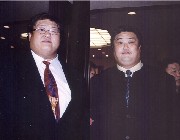| Brothers in Sumo – part one Brian Lewin |
 |
NHK & the Ozumo
English Broadcast
Mark Buckton
A visit to NHK, years of watching the show and the opinions of our Ed-in-Chief
Hanging With the Rikishi
Barbara Ann Klein
Barbara Ann Klein recounts her experiences with the “boys” in a pictorial diary series
| Rikishi of Old Joe Kuroda |
 |
Sumo Exhibit at the
Edo-Tokyo Museum
Barbara Ann Klein
SFM’s Editor takes in the exhibit celebrating 80 years of the Japan Sumo Association at this famous Tokyo museum
| Heya Peek John Gunning |
 |
| SFM Interview Dave Wiggins sits down |
 |
Photo Bonanza
What a collection – All-Japan Sumo Tournament, Hakkaku-
beya visit and sumo exhibits at the Edo-Tokyo Museum
Kyushu Basho Review
Lon Howard
Lon gives us his Kyushu Basho summary, along with the henka sightings results, and his take on the year in brief
Lower Division Rikishi
Mikko Mattila
Mikko Mattila covers lower division ups and downs
| Hatsu Basho Forecast Pierre Wohlleben & Mark Buckton |
 |
Sumo 101
Eric Blair
Eric explains all you need to know and then some about the Kokugikan building – the mecca of sumo
| Kimarite Focus Mikko Mattila |
 |
Minusha
John McTague
John’s unique bimonthly view of news from outside the dohyo
Online Gaming
Eric Blair
For the lowdown on Guess the Kotomitsuki – baby of SFM’s John Gunning
Kokugi Connections
Todd Lambert
Todd’s bimonthly focus on 3 of the most interesting sumo sites today
| Fan Debate Intra heya bouts – |
 |
SFM Cartoons
Stephen Thompson
In the second of our cartoon bonanzas, sit back and enjoy ST’s offerings
Let’s Hear From You
What was it that made you a sumo fan? American Todd Defoe tells all
Readers’ Letters
See what SFM readers had to say since our last issue
Sumo Quiz
The Quizmaster
Answer the Qs and win yourself next basho’s banzuke.
Salt Shaker and Plum Town

Nishikido and the former Umenosato
Koizumi Masato was scouted out by great Hawaiian sekiwake Takamiyama on a trip to Mito, Ibaraki Prefecture in the late ’70s. He made his debut with Takasago-beya in the 1978 Haru basho. He began as Koizumi, but three years later was given the shikona Mitoizumi, in honor of his famous hometown.
Exactly two years after Mitoizumi joined, he would be followed into the heya by his younger brother Shoji, who would take the name Umenosato, from the ume – plum/apricot that is Mito’s most famous product. Unfortunately, Umenosato would not meet with the same success as his brother.
Even if they couldn’t do it together, Mitoizumi would do his brother proud and would become one of the most tenacious and popular rikishi of his time.
A big man at 194 cm, Mitoizumi took longer than expected – six years – to make it to juryo but stayed for only two basho, making his makuuchi debut in the September 1984 basho. He moved up and down the banzuke, but managed to impress enough to claim three kanto-sho in his first two years.
The Aki basho in September 1986 would prove to be one of the defining moments of Mitoizumi’s career. On the third day, facing future yokozuna Onokuni, he was twisted and forced down on his left knee, seriously injuring it. After a lot of rehabilitation and moral support from his brother, he would eventually return to the
Oddly enough though, that leg injury was not the catalyst for the behavior that would help make him so popular and influence certain other recently-popular rikishi. As he stood in the corner for the last time before the tachiai, he would grab an enormous handful of salt and underhand it in a huge arc across the dohyo. Then, as he walked out to face his opponent, he would strike his face and shoulders to help focus his energy. Earning the nickname Salt Shaker, combined with a strong fighting spirit (6 kanto-sho and 1 shukun-sho) both in his torikumi and in battling through all his injuries, helped make him enormously popular with the fans.
Almost six years after the debilitating knee injury, in the 1992 Nagoya basho, Mitoizumi had perhaps the high point of his career. Capitalizing on his size, reach and power to their utmost, he won a spectacular 13-2 hiramaku yusho ranked at Maegashira 1.
For that, he was elevated to sekiwake the following basho, but was unable to capitalize on
Next Home
